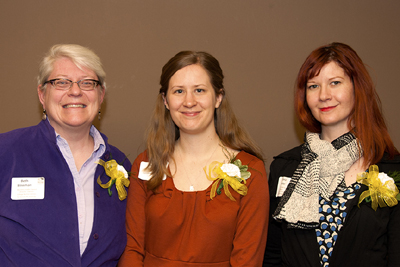Celebrating 20 Years of Community Service
Monday, April 27th, 2015By Laurie Stein (Oberlin College 2006)
The Oberlin Heritage Center was delighted that former intern Laurie Stein was able to return to her alma mater to celebrate the 20th Anniversary of the Community Services Work-Study Program of Oberlin College, and also to present at the Annual Meeting of the Oberlin Heritage Center on April 1, 2015. The Oberlin Heritage Center has been a community partner since the inception of the work study program. Here we reprint Laurie’s remarks on the impact community service at the Heritage Center had on her future career path. Laurie Stein is Curator of the Lake Forest – Lake Bluff Historical Society.
First of all I want to thank the staff at the Heritage Center and Tania Boster and Beth Blissman at Oberlin College for inviting me here this week. It’s wonderful to see a lot of familiar faces and see the many steps forward taken by this organization since my time here. It’s hard to believe that in 2016 it will be ten years since I graduated from Oberlin.
The reason I’m joining you today is to celebrate the 20-year partnership between the Oberlin Heritage Center and the college’s Community Services Work-Study Program, which has been absolutely wonderful. I give it all the credit in the world for allowing me to take my study of history and hone it into a passion for interpreting the past for a public audience.
I first became connected with the Oberlin Heritage Center through a Winter Term project in my second year. I conducted research for the Ohio Historic Inventory, surveying buildings and architecture and using archives to discover their former occupants.
At the end of the three-week winter term period, I recall thinking what a shame it was that my part in the project was ending. I was just starting to become familiar with the resources and with Oberlin’s built environment and there was so much more to do! But with double majoring, playing soccer, and working to help pay my tuition, I did not realistically see how I could continue as a volunteer, at least not on a regular basis.
So I was absolutely thrilled when Pat Murphy told me that as a work study student, I could apply to continue working there during the school year through the Community Services Work-Study Program, since the Oberlin Heritage Center was one of their community partners.
Beth Blissman, Director of the Bonner Center for Service and Learning, Laurie Stein, and Tania Boster, Director of the Community Services Work-Study Program
This was just terrific news, that I could work to defray the cost of my attendance at school in the field that I was interested in. I think I had an inkling even then that this wasn’t just a career-building opportunity; for me this might be the career-building opportunity.
And so I continued as an intern at the Heritage Center for the rest of my time at Oberlin, including over one summer, and then after I graduated, as a Museum Fellow for a year.
It was during this time that the Oberlin Heritage Center taught me what the “public” part of public historian really meant. At first I thought that for me it meant doing research that someone else would interpret – it was what I initially considered myself best at, being the most like “writing papers,” which I had already conquered as a history major. But after that first Winter Term, I was pushed out of my comfort zone, and I worked on not just the inventory, but on any number of other projects: giving tours, docent training, special events, stuffing envelopes for membership mailings, scanning photographs, summer camps, updating the website, taking photos of gravestones at the cemetery, copyediting the annual report, demonstrating the use of stilts on the lawn in front of the schoolhouse, and much more – all things, maybe except for the stilts, that I use regularly in my current job in Lake Forest.
This was a wonderful aspect of my intern experience at the OHC, that I wasn’t just buttonholed into one project. I really got a chance to see the inner workings of a small, active history museum – a museum that had become, thanks to Pat Murphy and Mary Anne Cunningham and all of you who are here tonight, a model for other history museums across the country, including mine in Lake Forest.
All of these experiences were invaluable when I applied to graduate school, and they were invaluable in signaling that I wanted to start my career at a museum like this one, where I would be able to work closely with our interns, our board, our volunteers – where I could get to know our museum members by name and say hello to them at events – where I could help develop innovative programs and provide services to the local community. The museum where I work now, the Lake Forest-Lake Bluff Historical Society, is just starting a regular internship program with our local college, Lake Forest College, and I can only hope that eventually it has a similar impact to what I was lucky enough to experience here through the Heritage Center and the Community Services Work-Study Program. Thank you.







